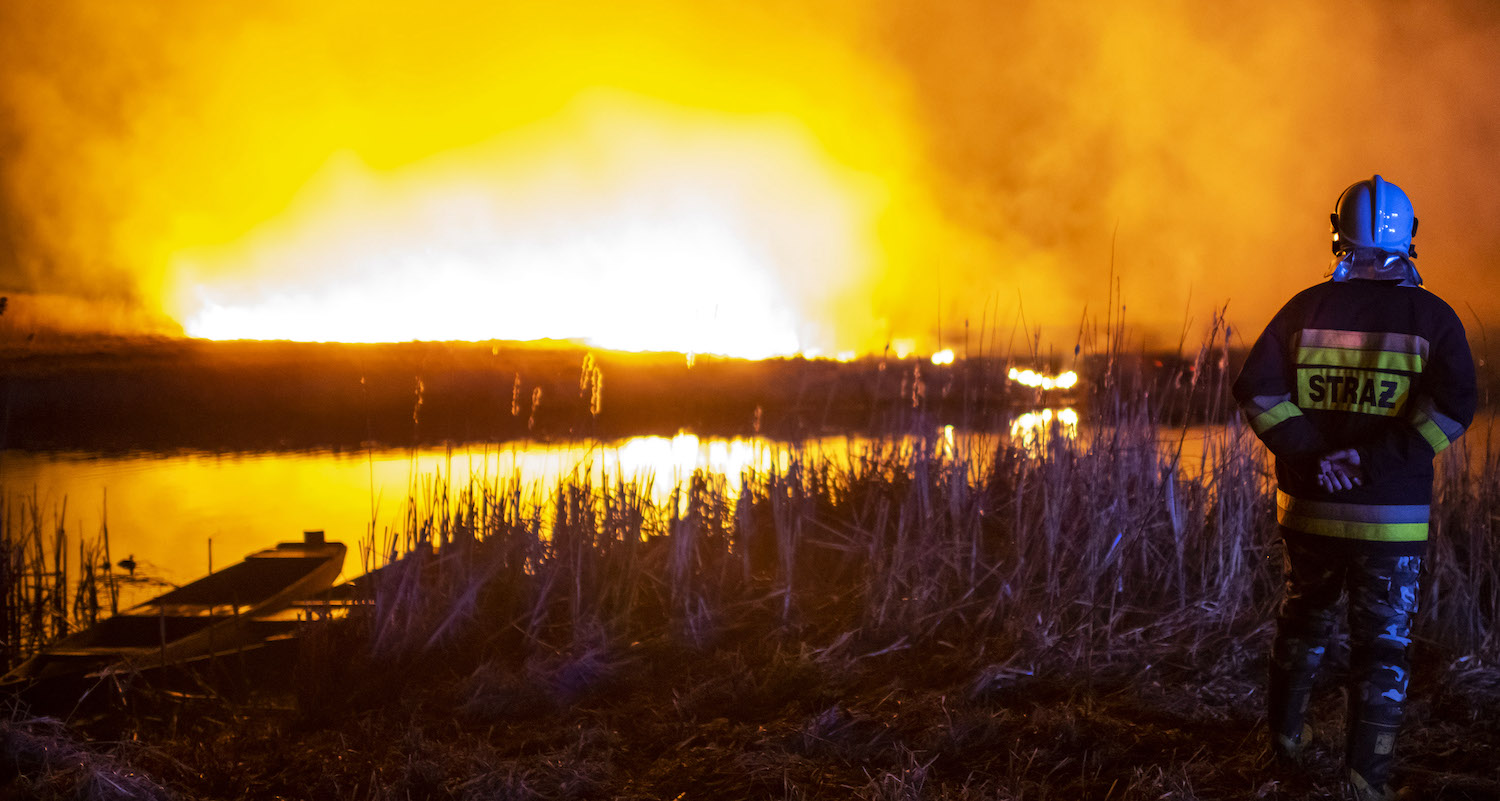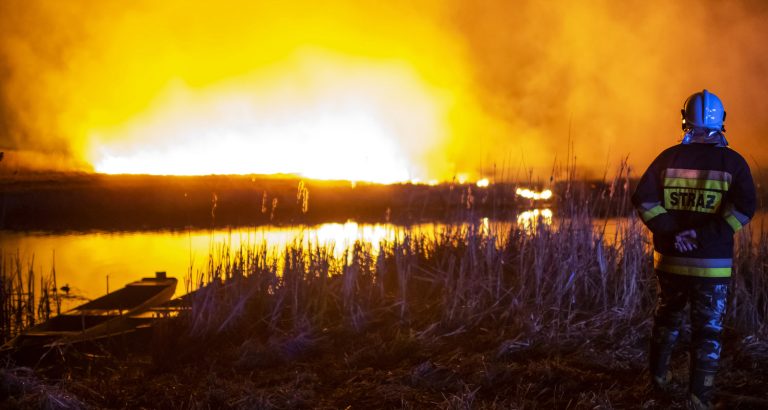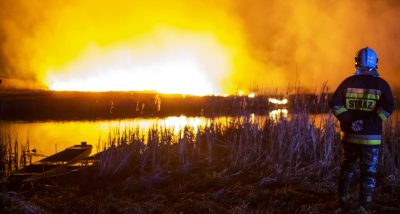Davide Mancini (Voxeurop)
György Folk, László Arató (Eurologus) 2024-02-08
Davide Mancini (Voxeurop)
György Folk, László Arató (Eurologus) 2024-02-08
Large forest and grassland fires are one of the most dramatic consequences of the ongoing climate catastrophe. Year after year, media coverage of fires ravaging Canada, Australia, Greece or Portugal is increasing; rising temperatures, however, mean that the threat is growing in many areas of the world – including Central Europe.
The fire was spotted by a farmer working in a field. It was hard to believe that the marshes and wetlands of the Polish Biebrza River could be on fire – but the drought in the fall of 2020 made peat more like straw. Strong winds intensified the fire and hampered rescue efforts. 1,500 firefighters – professionals and volunteers – battled it for a week. It covered 5,500 hectares of extremely valuable natural areas.
The fire in the Biebrza National Park shocked Poles, who followed media coverage of its extinguishing for days. It seemed like an incomprehensible freak of nature. Unfortunately, as climate change continues, we may see such images more and more often. Are we prepared for it?
We decided to compare the degree of preparedness for this threat in three countries: we started with Portugal, which has been dealing with wildfires for years, then looked at Hungary, where climate warming is becoming more and more noticeable, and ended with Poland, where awareness of the threat is still negligible. What can Central European countries learn from what is already happening in the south of our continent? Are they prepared for the worst case scenarios?
Why analyze this phenomenon at all? The answer is provided by the following visualization from Civio, also a member of EDJNet. It shows how fire weather risk index has been increasing in all three countries in recent years.
The juxtaposition of the number of fires in the three countries is interesting. In Poland and Portugal a similar area has burned, but in Poland the number is two to three times higher. Of course, an exceptional year and an exceptional fire – like the one in Biebrza National Park in 2020 – need to be taken into account.
The issue of forecasting and detecting fire is limping along in Hungary, where the appropriate tools are lacking. Poland and Portugal have successful integrated systems for predicting and monitoring upcoming and current fire danger, which are available online.
In Portugal, fires during the summer season are so prevalent that civil defense services provide online maps with active fires and firefighting actions in real time, which citizens are eager to use for their own safety.
Poland leads in the number of electronic tools for fire observation and detection (242) and observation towers (420). Portugal uses 120 cameras installed in the most strategic locations and 230 points where observation is carried out in real time. The Hungarian service does not use electronic tools, nor has it released information on how many observation towers it has.
When a fire is detected, the Poles rely on heavy land equipment – as a whole, fire services have 20,000 fire engines at their disposal, whose fleet is systematically upgraded every year with both national and EU funds. Portuguese services have only less than 3 thousand such vehicles. We were unable to obtain precise numbers from Hungary, except that firefighters use 63 different types of vehicles and that 30 of these are equipped to fight forest fires.
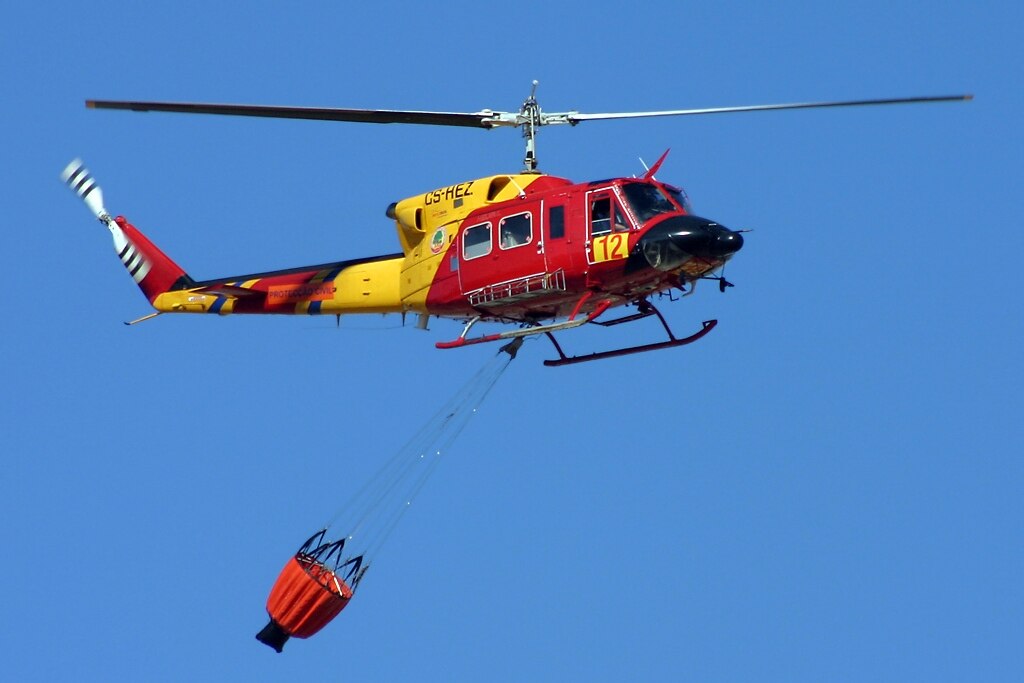
Portuguese helicopter with “bambi bucket.” Photo: Pedro Aragão / Wikimedia Commons, CC 3.0
In the air, the Portuguese have a proper fleet: 18 medium-sized aircraft capable of dropping 3,000 liters of water at a time, and four units with a capacity of 5,000 liters. Plus 46 helicopters, three of which really large, with tanks that can carry 4,000 liters of water. The Polish fire service does not have its own aircraft or helicopters; it has only eight “bambi bucket” tanks, with capacities between 680 and 3,000 liters, which they hook up to rented helicopters, or a police Black-Hawk. Five PZL M18 Dromader aircraft, of 1970s design, fly under the State Forests department.
Shovel better than fire truck
Why so much difference? An explanation has been provided to us by Przemyslaw Rembielak and Bartosz Klich, professional firefighters with years of experience in several continents: “Although it may not be apparent during a weekend walk in a Polish forest, our forests are laced with a grid of well-prepared, maintained and carefully mapped fire roads, which are overseen by the State Forests department. On top of that, there are water points and designated places for maneuvering, everything is prepared for heavy vehicles that can carry a lot of water. In comparison, during the huge fires in Sweden in 2018, harvesters, huge machines for large-scale forest clearing, had to go in front of fire trucks with water to create access roads promptly, as the forest was not prepared by local foresters for this purpose”.
“In Portugal, it looks very different. Narrow, winding roads that end not far from the villages – these are conditions for which multi-tonne vehicles with small water tanks are not adapted”, the firefighters add.
“The Poles are able to build 3 km of hose from 17 vehicles, but a thick one, with a diameter of 110 mm, which is the right capacity to extinguish fires in buildings, warehouses, and garbage dumps. In southern Europe, 3 km of hoses are carried by one car, because to extinguish forest and grassland fires 25 mm in diameter is sufficient, the water is sprayed more slowly and can be used more efficiently. This is complemented by the infantry, who use shovels to bury or cover. These relatively simple tasks can be performed by trained volunteers under the guidance of qualified commanders, there is no need for professional firefighters across half the country”, the experts explain.
Prevention First
Of course, it is always better to try to prevent fires than having to put them out. However, this requires thinking years and sometimes decades in advance.
One of the biggest problems of a warming world are fires that occur at the point of intersection between urbanized and natural areas: these areas are called “Wildland-Urban Interface” (WUI). Due to growing populations and migration from cities, forest and grassland fires are becoming increasingly devastating to infrastructures and human life – just recall the tragic story of the American town of Paradise, located in a picturesque corner of California, at the foot of the Sierra Nevada mountains. When a fire broke out in the surrounding forest in 2018, evacuation from the overly dense settlements was possible via a single exit road. The disaster killed 85 people and destroyed 18,000 buildings. In a matter of hours the little paradise became a blazing inferno.
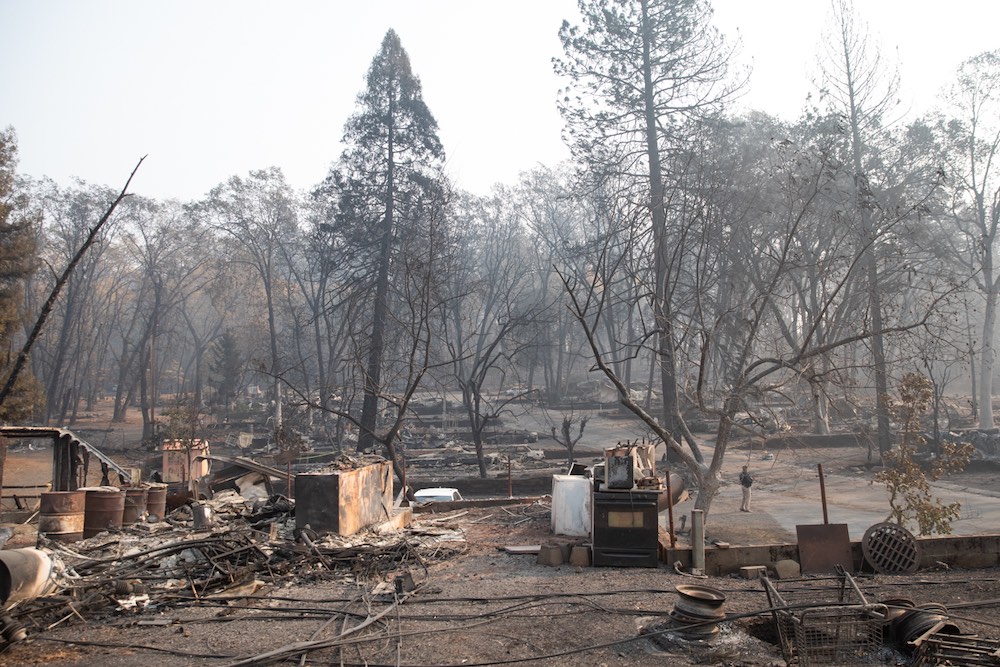
Paradise after the tragic wildfire in 2018. Photo: Shealah Craighead / White House / Wikimedia Commons
Portugal, the country most affected by fires among the three we are analyzing, is well aware of this danger. The country draws up Municipal Forest Fire Protection Plans (PMDFCIs), which identify densely populated areas within or adjacent to forest areas with a high risk of fire. Municipal authorities are responsible for establishing protection zones with a minimum width of 100 meters. However, mapping such sites can be a difficult task, and as a result, authorities often primarily respond to reports of existing hazards.
Unfortunately, similar legislation still does not exist in either Hungary or Poland – even though experts warn that in the near future residential areas could face the same danger as in southern Europe.
Another extremely effective preventive tool is controlled burnings, but they are still used very cautiously in the countries we surveyed. In Hungary, no such method is practiced. In Poland, controlled burnings are used on an experimental basis for the active protection of heathlands. In Portugal, for the time being, they are used only in selected locations, but there are plans to expand the use of this method.
Minimizing the risk of fire is an important mission for institutions managing forests and other natural areas. Besides more common measures such as as the creation of fire lanes or the preservation of access roads, a more far-reaching approach is to plan the plant species composition of future forests to make them more resistant to the elements. This is most evident in Portugal, where efforts are being made to replace eucalyptus, a species not naturally occurring there and extremely flammable, with native plants that pose a much lower fire risk.
If today we feel that the problem does not concern Central Europe, let’s recall the images of the Biebrza swamps burning in Poland. In the coming years, we won’t be able to prevent the advancing drought and increasingly higher temperatures – but it’s worth thinking about how to reduce future damages.
Cover photo:Wildfire in Biebrza, Poland, 22.04.2020. Photo: Michal Kosc / Forum
 This material is published in the context of the “FIRE-RES” project co-funded by the European Union (EU). The EU is in no way responsible for the information or views expressed within the framework of the project. Responsibility for the content lies solely with EDJNet. Go to the FIRE-RES page
This material is published in the context of the “FIRE-RES” project co-funded by the European Union (EU). The EU is in no way responsible for the information or views expressed within the framework of the project. Responsibility for the content lies solely with EDJNet. Go to the FIRE-RES page
EDJNet is a network of media organisations from all across Europe, producing and promoting data-driven coverage of European issues. FRONTSTORY.PL is a part of this network.

